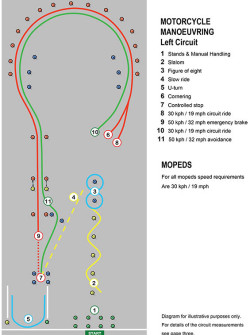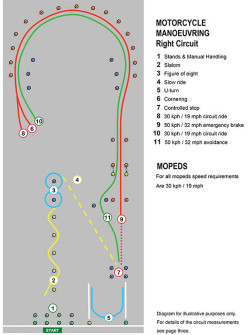
Practical Motorcycle Test
Since April 2009, the motorcycle test will consist of two modules, Module 1 is the off-road manoeuvring test and Module 2 is the On-road Test. It is no more difficult to pass this test than the one that preceded it, providing that you have been taught how to ride a motorcycle safely. This is what we do from day 1 of learning at VMT.
Both parts of the test can be conducted on a single day at one of the Driving Standards Agency’s new M.P.T.C. (Multi-Purpose Test Centres) but if you fail Module 1, you will not be allowed to take Module 2 on the same day. We will only book both parts of the test on the same day if we are very confident that you will pass.
Ultimately, the choice will be yours but the second option is to take both modules separately, allowing you to progress at your own rate rather than the pressure of an “intensive” course. Once module one has been passed, this can be “banked” for up to two years, running alongside the theory test. Module two can then be taken when you are ready but before your theory test expires.
Module 1 will take approximately 15 minutes to complete on the MMA (Motorcycle Manoeuvring Area) and 55 minutes for Module 2 (on road). The MMA is a flat level tarmac area of 125 metres long by 40 metres wide (5000 sq metres).
There will be both a Left and Right circuit available on the MMA and the examiners will change between the two on a regular basis.
Circuit Layout


Module 1 comprises the series of manoeuvres listed below.
- On and off the stand. - This can be either the main or side stand.
- Wheel the machine. - This will involve pushing the machine backwards between two set of cones in a reverse U-Turn.
- Slalom - Ride through 5 cones in a slalom. (4.5 meters apart)
- Figure of eight. – Ride a figure of eight twice between two cones. (6 meters apart)
- Slow ride – This is over a distance of approximately 17 meters, which must be ridden at walking pace as if to simulate riding in slow moving traffic. You must complete this without putting your feet down, until you come to a controlled stop.
- U-Turn – The U-Turn must be completed in between two lines that are 7.5 metres apart. (So no more kerbs to worry about!)
- 30kph circuit ride. – (18.64 mph). This involves riding the radius at one end of the MMA, (this is not speed timed).
- Controlled stop. – After you have ridden the circuit, you must perform a controlled stop with the front wheel in between the four blue cones.
- 30kph circuit ride. – (18.64 mph). This involves riding the radius at one end of the MMA, (this is not speed timed).
- 50kph stop as if in an emergency. – (31.068 mph). To perform the emergency stop exercise, you must again come through the timing gates at the minimum speed of 50kph; you are given two attempts to reach the minimum speed to pass this part of the test.
- 30kph circuit ride. – (18.64 mph). This involves riding the radius at one end of the MMA, N.B this is not speed timed.
- 50kph avoidance – (31.068 mph). This is the main part of the off road element. You must reach the minimum speed of 50kph between the timing gates before changing direction to either the left or right, this will ensure that all motorcyclists are equipped with the skills necessary to avoid another vehicle user “pulling out” in front of them, or safely negotiating a hazard in the road i.e. deep pothole. You are given two attempts to reach the minimum speed, to pass this part of the test.
- MMA Circuit layout (Left & Right) As from May 2011 the minimum speed has now been reduced to 48kph (29.85 mph) for both the avoidance manoeuvre and emergency stop. If you do less than the required 50Kmh but do at least 48kmh on both the emergency stop and the avoidance manoeuvre, you will pick up 1 rider error mark. You are allowed 5 rider error marks on the Module 1 test.
If you do less than 48Kmh on both of the above then you will be asked to do the manoeuvre again (only once though, so make sure the speed is right!).
Once Module 1 has been passed, Module 2 is taken out on the public road where the examiner will check your documents, eyesight and kit you out with one of their radios (very similar to the one your instructor uses).
You are then asked the safety questions and the practical maintenance questions before the practical road ride.
The examiner will give you directions using a radio and they will normally follow you on a motorcycle. You will ride in a variety of road and traffic conditions and you are allowed 10 rider error marks on the Module 2 test. You’ll be asked to carry out:
- Normal stops
- An angle start (pulling out from behind a parked vehicle)
- A hill start (where possible)
- Junctions
- Roundabouts
- One-way systems
- Dual Carriageways (where possible)
Independent riding section of the riding test
Your riding test will include around ten minutes of independent riding. This is designed to assess your ability to ride safely while making decisions independently.
Clothing rules
You must wear:
- A motorcycle helmet that meets British safety standards (this doesn’t apply if you’re Sikh and wearing a turban)
- Motorcycle boots or other sturdy footwear that provides support and ankle protection
- Textile or leather motorcycle trousers or heavy denim trousers
- A textile or leather motorcycle jacket or a heavy denim jacket with several layers underneath
- Motorcycle gloves
Your test will be cancelled and you’ll lose your fee if you don’t meet these standards!